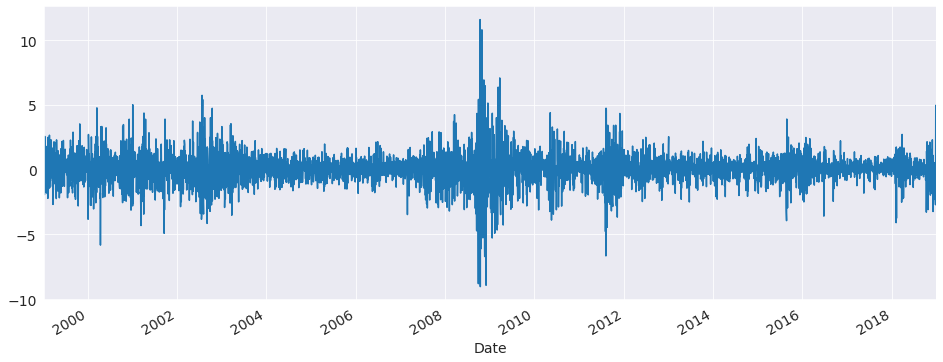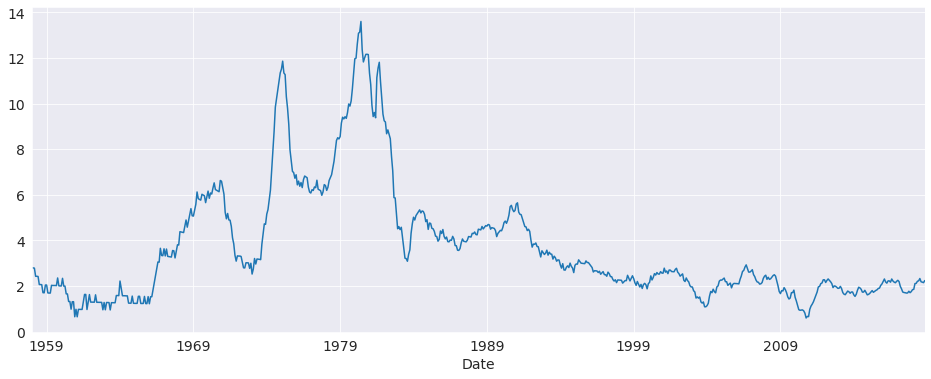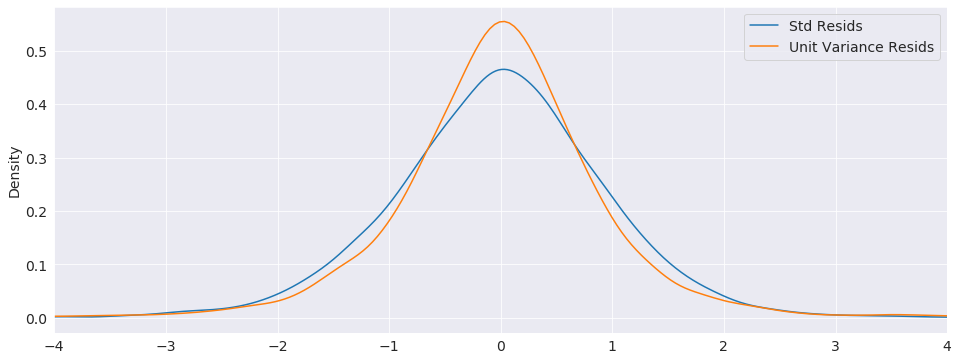ARCH Modeling¶
This setup code is required to run in an IPython notebook
[1]:
import warnings
warnings.simplefilter('ignore')
%matplotlib inline
import matplotlib.pyplot as plt
import seaborn
seaborn.set_style('darkgrid')
plt.rc("figure", figsize=(16, 6))
plt.rc("savefig", dpi=90)
plt.rc("font",family="sans-serif")
plt.rc("font",size=14)
Setup¶
These examples will all make use of financial data from Yahoo! Finance. This data set can be loaded from arch.data.sp500.
[2]:
import datetime as dt
import arch.data.sp500
st = dt.datetime(1988, 1, 1)
en = dt.datetime(2018, 1, 1)
data = arch.data.sp500.load()
market = data['Adj Close']
returns = 100 * market.pct_change().dropna()
ax = returns.plot()
xlim = ax.set_xlim(returns.index.min(), returns.index.max())

Specifying Common Models¶
The simplest way to specify a model is to use the model constructor arch.arch_model which can specify most common models. The simplest invocation of arch will return a model with a constant mean, GARCH(1,1) volatility process and normally distributed errors.
The model is estimated by calling fit. The optional inputs iter controls the frequency of output form the optimizer, and disp controls whether convergence information is returned. The results class returned offers direct access to the estimated parameters and related quantities, as well as a summary of the estimation results.
GARCH (with a Constant Mean)¶
The default set of options produces a model with a constant mean, GARCH(1,1) conditional variance and normal errors.
[3]:
from arch import arch_model
am = arch_model(returns)
res = am.fit(update_freq=5)
print(res.summary())
Iteration: 5, Func. Count: 39, Neg. LLF: 6942.159596737265
Iteration: 10, Func. Count: 72, Neg. LLF: 6936.718529994181
Optimization terminated successfully. (Exit mode 0)
Current function value: 6936.718476989043
Iterations: 11
Function evaluations: 79
Gradient evaluations: 11
Constant Mean - GARCH Model Results
==============================================================================
Dep. Variable: Adj Close R-squared: -0.001
Mean Model: Constant Mean Adj. R-squared: -0.001
Vol Model: GARCH Log-Likelihood: -6936.72
Distribution: Normal AIC: 13881.4
Method: Maximum Likelihood BIC: 13907.5
No. Observations: 5030
Date: Mon, Mar 02 2020 Df Residuals: 5026
Time: 11:53:28 Df Model: 4
Mean Model
============================================================================
coef std err t P>|t| 95.0% Conf. Int.
----------------------------------------------------------------------------
mu 0.0564 1.149e-02 4.906 9.302e-07 [3.384e-02,7.887e-02]
Volatility Model
============================================================================
coef std err t P>|t| 95.0% Conf. Int.
----------------------------------------------------------------------------
omega 0.0175 4.683e-03 3.738 1.854e-04 [8.328e-03,2.669e-02]
alpha[1] 0.1022 1.301e-02 7.852 4.105e-15 [7.665e-02, 0.128]
beta[1] 0.8852 1.380e-02 64.125 0.000 [ 0.858, 0.912]
============================================================================
Covariance estimator: robust
plot() can be used to quickly visualize the standardized residuals and conditional volatility.
[4]:
fig = res.plot(annualize='D')

GJR-GARCH¶
Additional inputs can be used to construct other models. This example sets o to 1, which includes one lag of an asymmetric shock which transforms a GARCH model into a GJR-GARCH model with variance dynamics given by
where \(I\) is an indicator function that takes the value 1 when its argument is true.
The log likelihood improves substantially with the introduction of an asymmetric term, and the parameter estimate is highly significant.
[5]:
am = arch_model(returns, p=1, o=1, q=1)
res = am.fit(update_freq=5, disp='off')
print(res.summary())
Constant Mean - GJR-GARCH Model Results
==============================================================================
Dep. Variable: Adj Close R-squared: -0.000
Mean Model: Constant Mean Adj. R-squared: -0.000
Vol Model: GJR-GARCH Log-Likelihood: -6822.88
Distribution: Normal AIC: 13655.8
Method: Maximum Likelihood BIC: 13688.4
No. Observations: 5030
Date: Mon, Mar 02 2020 Df Residuals: 5025
Time: 11:53:28 Df Model: 5
Mean Model
=============================================================================
coef std err t P>|t| 95.0% Conf. Int.
-----------------------------------------------------------------------------
mu 0.0175 1.145e-02 1.529 0.126 [-4.936e-03,3.995e-02]
Volatility Model
=============================================================================
coef std err t P>|t| 95.0% Conf. Int.
-----------------------------------------------------------------------------
omega 0.0196 4.051e-03 4.830 1.362e-06 [1.163e-02,2.751e-02]
alpha[1] 3.3117e-10 1.026e-02 3.227e-08 1.000 [-2.011e-02,2.011e-02]
gamma[1] 0.1831 2.266e-02 8.079 6.543e-16 [ 0.139, 0.227]
beta[1] 0.8922 1.458e-02 61.200 0.000 [ 0.864, 0.921]
=============================================================================
Covariance estimator: robust
TARCH/ZARCH¶
TARCH (also known as ZARCH) model the volatility using absolute values. This model is specified using power=1.0 since the default power, 2, corresponds to variance processes that evolve in squares.
The volatility process in a TARCH model is given by
More general models with other powers (\(\kappa\)) have volatility dynamics given by
where the conditional variance is \(\left(\sigma_t^\kappa\right)^{2/\kappa}\).
The TARCH model also improves the fit, although the change in the log likelihood is less dramatic.
[6]:
am = arch_model(returns, p=1, o=1, q=1, power=1.0)
res = am.fit(update_freq=5)
print(res.summary())
Iteration: 5, Func. Count: 49, Neg. LLF: 6807.734808859357
Iteration: 10, Func. Count: 88, Neg. LLF: 6799.179902576483
Optimization terminated successfully. (Exit mode 0)
Current function value: 6799.17852245191
Iterations: 14
Function evaluations: 116
Gradient evaluations: 13
Constant Mean - TARCH/ZARCH Model Results
==============================================================================
Dep. Variable: Adj Close R-squared: -0.000
Mean Model: Constant Mean Adj. R-squared: -0.000
Vol Model: TARCH/ZARCH Log-Likelihood: -6799.18
Distribution: Normal AIC: 13608.4
Method: Maximum Likelihood BIC: 13641.0
No. Observations: 5030
Date: Mon, Mar 02 2020 Df Residuals: 5025
Time: 11:53:28 Df Model: 5
Mean Model
=============================================================================
coef std err t P>|t| 95.0% Conf. Int.
-----------------------------------------------------------------------------
mu 0.0143 1.091e-02 1.311 0.190 [-7.080e-03,3.570e-02]
Volatility Model
=============================================================================
coef std err t P>|t| 95.0% Conf. Int.
-----------------------------------------------------------------------------
omega 0.0258 4.100e-03 6.299 2.986e-10 [1.779e-02,3.386e-02]
alpha[1] 3.0844e-09 9.156e-03 3.369e-07 1.000 [-1.794e-02,1.794e-02]
gamma[1] 0.1707 1.601e-02 10.664 1.499e-26 [ 0.139, 0.202]
beta[1] 0.9098 9.672e-03 94.066 0.000 [ 0.891, 0.929]
=============================================================================
Covariance estimator: robust
Student's T Errors¶
Financial returns are often heavy tailed, and a Student's T distribution is a simple method to capture this feature. The call to arch changes the distribution from a Normal to a Students's T.
The standardized residuals appear to be heavy tailed with an estimated degree of freedom near 10. The log-likelihood also shows a large increase.
[7]:
am = arch_model(returns, p=1, o=1, q=1, power=1.0, dist='StudentsT')
res = am.fit(update_freq=5)
print(res.summary())
Iteration: 5, Func. Count: 54, Neg. LLF: 6726.104807616888
Iteration: 10, Func. Count: 99, Neg. LLF: 6722.153431139288
Optimization terminated successfully. (Exit mode 0)
Current function value: 6722.151184378068
Iterations: 13
Function evaluations: 121
Gradient evaluations: 12
Constant Mean - TARCH/ZARCH Model Results
====================================================================================
Dep. Variable: Adj Close R-squared: -0.000
Mean Model: Constant Mean Adj. R-squared: -0.000
Vol Model: TARCH/ZARCH Log-Likelihood: -6722.15
Distribution: Standardized Student's t AIC: 13456.3
Method: Maximum Likelihood BIC: 13495.4
No. Observations: 5030
Date: Mon, Mar 02 2020 Df Residuals: 5024
Time: 11:53:28 Df Model: 6
Mean Model
============================================================================
coef std err t P>|t| 95.0% Conf. Int.
----------------------------------------------------------------------------
mu 0.0323 2.299e-03 14.037 9.214e-45 [2.776e-02,3.677e-02]
Volatility Model
=============================================================================
coef std err t P>|t| 95.0% Conf. Int.
-----------------------------------------------------------------------------
omega 0.0201 3.492e-03 5.745 9.185e-09 [1.322e-02,2.691e-02]
alpha[1] 2.4040e-09 8.223e-03 2.924e-07 1.000 [-1.612e-02,1.612e-02]
gamma[1] 0.1721 1.512e-02 11.386 4.931e-30 [ 0.143, 0.202]
beta[1] 0.9139 9.578e-03 95.415 0.000 [ 0.895, 0.933]
Distribution
========================================================================
coef std err t P>|t| 95.0% Conf. Int.
------------------------------------------------------------------------
nu 7.9550 0.880 9.036 1.627e-19 [ 6.229, 9.680]
========================================================================
Covariance estimator: robust
Fixing Parameters¶
In some circumstances, fixed rather than estimated parameters might be of interest. A model-result-like class can be generated using the fix() method. The class returned is identical to the usual model result class except that information about inference (standard errors, t-stats, etc) is not available.
In the example, I fix the parameters to a symmetric version of the previously estimated model.
[8]:
fixed_res = am.fix([0.0235, 0.01, 0.06, 0.0, 0.9382, 8.0])
print(fixed_res.summary())
Constant Mean - TARCH/ZARCH Model Results
=====================================================================================
Dep. Variable: Adj Close R-squared: --
Mean Model: Constant Mean Adj. R-squared: --
Vol Model: TARCH/ZARCH Log-Likelihood: -6908.93
Distribution: Standardized Student's t AIC: 13829.9
Method: User-specified Parameters BIC: 13869.0
No. Observations: 5030
Date: Mon, Mar 02 2020
Time: 11:53:28
Mean Model
=====================
coef
---------------------
mu 0.0235
Volatility Model
=====================
coef
---------------------
omega 0.0100
alpha[1] 0.0600
gamma[1] 0.0000
beta[1] 0.9382
Distribution
=====================
coef
---------------------
nu 8.0000
=====================
Results generated with user-specified parameters.
Std. errors not available when the model is not estimated,
[9]:
import pandas as pd
df = pd.concat([res.conditional_volatility, fixed_res.conditional_volatility],
1)
df.columns = ['Estimated', 'Fixed']
subplot = df.plot()
subplot.set_xlim(xlim)
[9]:
(729759.0, 737059.0)

Building a Model From Components¶
Models can also be systematically assembled from the three model components:
A mean model (
arch.mean)Zero mean (
ZeroMean) - useful if using residuals from a model estimated separatelyConstant mean (
ConstantMean) - common for most liquid financial assetsAutoregressive (
ARX) with optional exogenous regressorsHeterogeneous (
HARX) autoregression with optional exogenous regressorsExogenous regressors only (
LS)
A volatility process (
arch.volatility)ARCH (
ARCH)GARCH (
GARCH)GJR-GARCH (
GARCHusingoargument)TARCH/ZARCH (
GARCHusingpowerargument set to1)Power GARCH and Asymmetric Power GARCH (
GARCHusingpower)Exponentially Weighted Moving Average Variance with estimated coefficient (
EWMAVariance)Heterogeneous ARCH (
HARCH)Parameterless Models
Exponentially Weighted Moving Average Variance, known as RiskMetrics (
EWMAVariance)Weighted averages of EWMAs, known as the RiskMetrics 2006 methodology (
RiskMetrics2006)
A distribution (
arch.distribution)Normal (
Normal)Standardized Students's T (
StudentsT)
Mean Models¶
The first choice is the mean model. For many liquid financial assets, a constant mean (or even zero) is adequate. For other series, such as inflation, a more complicated model may be required. These examples make use of Core CPI downloaded from the Federal Reserve Economic Data site.
[10]:
import arch.data.core_cpi
core_cpi = arch.data.core_cpi.load()
ann_inflation = 100 * core_cpi.CPILFESL.pct_change(12).dropna()
fig = ann_inflation.plot()

All mean models are initialized with constant variance and normal errors. For ARX models, the lags argument specifies the lags to include in the model.
[11]:
from arch.univariate import ARX
ar = ARX(ann_inflation, lags=[1, 3, 12])
print(ar.fit().summary())
AR - Constant Variance Model Results
==============================================================================
Dep. Variable: CPILFESL R-squared: 0.991
Mean Model: AR Adj. R-squared: 0.991
Vol Model: Constant Variance Log-Likelihood: 11.2764
Distribution: Normal AIC: -12.5529
Method: Maximum Likelihood BIC: 10.3364
No. Observations: 719
Date: Mon, Mar 02 2020 Df Residuals: 714
Time: 11:53:29 Df Model: 5
Mean Model
===============================================================================
coef std err t P>|t| 95.0% Conf. Int.
-------------------------------------------------------------------------------
Const 0.0402 2.030e-02 1.981 4.762e-02 [4.218e-04,8.001e-02]
CPILFESL[1] 1.1921 3.475e-02 34.306 6.315e-258 [ 1.124, 1.260]
CPILFESL[3] -0.1798 4.076e-02 -4.411 1.030e-05 [ -0.260,-9.989e-02]
CPILFESL[12] -0.0232 1.370e-02 -1.692 9.058e-02 [-5.002e-02,3.666e-03]
Volatility Model
============================================================================
coef std err t P>|t| 95.0% Conf. Int.
----------------------------------------------------------------------------
sigma2 0.0567 6.449e-03 8.799 1.381e-18 [4.410e-02,6.938e-02]
============================================================================
Covariance estimator: White's Heteroskedasticity Consistent Estimator
Volatility Processes¶
Volatility processes can be added a a mean model using the volatility property. This example adds an ARCH(5) process to model volatility. The arguments iter and disp are used in fit() to suppress estimation output.
[12]:
from arch.univariate import ARCH, GARCH
ar.volatility = ARCH(p=5)
res = ar.fit(update_freq=0, disp='off')
print(res.summary())
AR - ARCH Model Results
==============================================================================
Dep. Variable: CPILFESL R-squared: 0.991
Mean Model: AR Adj. R-squared: 0.991
Vol Model: ARCH Log-Likelihood: 136.522
Distribution: Normal AIC: -253.044
Method: Maximum Likelihood BIC: -207.265
No. Observations: 719
Date: Mon, Mar 02 2020 Df Residuals: 709
Time: 11:53:29 Df Model: 10
Mean Model
===============================================================================
coef std err t P>|t| 95.0% Conf. Int.
-------------------------------------------------------------------------------
Const 0.0285 1.883e-02 1.513 0.130 [-8.411e-03,6.541e-02]
CPILFESL[1] 1.0860 3.534e-02 30.725 2.609e-207 [ 1.017, 1.155]
CPILFESL[3] -0.0788 3.855e-02 -2.045 4.084e-02 [ -0.154,-3.283e-03]
CPILFESL[12] -0.0189 1.157e-02 -1.630 0.103 [-4.154e-02,3.822e-03]
Volatility Model
============================================================================
coef std err t P>|t| 95.0% Conf. Int.
----------------------------------------------------------------------------
omega 7.6869e-03 1.602e-03 4.799 1.591e-06 [4.548e-03,1.083e-02]
alpha[1] 0.1345 4.003e-02 3.359 7.826e-04 [5.600e-02, 0.213]
alpha[2] 0.2280 6.284e-02 3.628 2.860e-04 [ 0.105, 0.351]
alpha[3] 0.1838 6.801e-02 2.702 6.894e-03 [5.047e-02, 0.317]
alpha[4] 0.2538 7.826e-02 3.242 1.185e-03 [ 0.100, 0.407]
alpha[5] 0.1954 7.092e-02 2.756 5.856e-03 [5.643e-02, 0.334]
============================================================================
Covariance estimator: robust
Plotting the standardized residuals and the conditional volatility shows some large (in magnitude) errors, even when standardized.
[13]:
fig = res.plot()

Distributions¶
Finally the distribution can be changed from the default normal to a standardized Student's T using the distribution property of a mean model.
The Student's t distribution improves the model, and the degree of freedom is estimated to be near 8.
[14]:
from arch.univariate import StudentsT
ar.distribution = StudentsT()
res = ar.fit(update_freq=0, disp='off')
print(res.summary())
AR - ARCH Model Results
====================================================================================
Dep. Variable: CPILFESL R-squared: 0.991
Mean Model: AR Adj. R-squared: 0.991
Vol Model: ARCH Log-Likelihood: 142.863
Distribution: Standardized Student's t AIC: -263.727
Method: Maximum Likelihood BIC: -213.370
No. Observations: 719
Date: Mon, Mar 02 2020 Df Residuals: 708
Time: 11:53:30 Df Model: 11
Mean Model
===============================================================================
coef std err t P>|t| 95.0% Conf. Int.
-------------------------------------------------------------------------------
Const 0.0312 1.861e-02 1.678 9.341e-02 [-5.254e-03,6.770e-02]
CPILFESL[1] 1.0843 3.525e-02 30.762 8.322e-208 [ 1.015, 1.153]
CPILFESL[3] -0.0730 3.873e-02 -1.885 5.947e-02 [ -0.149,2.915e-03]
CPILFESL[12] -0.0236 1.316e-02 -1.791 7.331e-02 [-4.935e-02,2.224e-03]
Volatility Model
============================================================================
coef std err t P>|t| 95.0% Conf. Int.
----------------------------------------------------------------------------
omega 8.7356e-03 2.063e-03 4.235 2.284e-05 [4.693e-03,1.278e-02]
alpha[1] 0.1715 5.064e-02 3.386 7.088e-04 [7.222e-02, 0.271]
alpha[2] 0.2202 6.394e-02 3.443 5.743e-04 [9.485e-02, 0.345]
alpha[3] 0.1547 6.327e-02 2.445 1.447e-02 [3.071e-02, 0.279]
alpha[4] 0.2117 7.287e-02 2.905 3.677e-03 [6.884e-02, 0.354]
alpha[5] 0.1959 7.853e-02 2.495 1.261e-02 [4.198e-02, 0.350]
Distribution
========================================================================
coef std err t P>|t| 95.0% Conf. Int.
------------------------------------------------------------------------
nu 9.0448 3.366 2.687 7.204e-03 [ 2.448, 15.642]
========================================================================
Covariance estimator: robust
WTI Crude¶
The next example uses West Texas Intermediate Crude data from FRED. Three models are fit using alternative distributional assumptions. The results are printed, where we can see that the normal has a much lower log-likelihood than either the Standard Student's T or the Standardized Skew Student's T -- however, these two are fairly close. The closeness of the T and the Skew T indicate that returns are not heavily skewed.
[21]:
from collections import OrderedDict
import arch.data.wti
crude = arch.data.wti.load()
crude_ret = 100 * crude.DCOILWTICO.dropna().pct_change().dropna()
res_normal = arch_model(crude_ret).fit(disp='off')
res_t = arch_model(crude_ret, dist='t').fit(disp='off')
res_skewt = arch_model(crude_ret, dist='skewt').fit(disp='off')
lls = pd.Series(
OrderedDict((('normal', res_normal.loglikelihood),
('t', res_t.loglikelihood), ('skewt',
res_skewt.loglikelihood))))
print(lls)
params = pd.DataFrame(
OrderedDict((('normal', res_normal.params), ('t', res_t.params),
('skewt', res_skewt.params))))
params
normal -18165.858870
t -17919.643916
skewt -17916.669052
dtype: float64
[21]:
| normal | t | skewt | |
|---|---|---|---|
| alpha[1] | 0.085627 | 0.064980 | 0.064889 |
| beta[1] | 0.909098 | 0.927950 | 0.928215 |
| lambda | NaN | NaN | -0.036986 |
| mu | 0.046682 | 0.056438 | 0.040928 |
| nu | NaN | 6.178652 | 6.186550 |
| omega | 0.055806 | 0.048516 | 0.047683 |
The standardized residuals can be computed by dividing the residuals by the conditional volatility. These are plotted along with the (unstandardized, but scaled) residuals. The non-standardized residuals are more peaked in the center indicating that the distribution is somewhat more heavy tailed than that of the standardized residuals.
[16]:
std_resid = res_normal.resid / res_normal.conditional_volatility
unit_var_resid = res_normal.resid / res_normal.resid.std()
df = pd.concat([std_resid, unit_var_resid], 1)
df.columns = ['Std Resids', 'Unit Variance Resids']
subplot = df.plot(kind='kde', xlim=(-4, 4))

Simulation¶
All mean models expose a method to simulate returns from assuming the model is correctly specified. There are two required parameters, params which are the model parameters, and nobs, the number of observations to produce.
Below we simulate from a GJR-GARCH(1,1) with Skew-t errors using parameters estimated on the WTI series. The simulation returns a DataFrame with 3 columns:
data: The simulated data, which includes any mean dynamics.volatility: The conditional volatility serieserrors: The simulated errors generated to produce the model. The errors are the difference between the data and its conditional mean, and can be transformed into the standardized errors by dividing by the volatility.
[17]:
res = arch_model(crude_ret, p=1, o=1, q=1, dist='skewt').fit(disp='off')
pd.DataFrame(res.params)
[17]:
| params | |
|---|---|
| mu | 0.029365 |
| omega | 0.044375 |
| alpha[1] | 0.044344 |
| gamma[1] | 0.036104 |
| beta[1] | 0.931280 |
| nu | 6.211329 |
| lambda | -0.041615 |
[18]:
sim_mod = arch_model(None, p=1, o=1, q=1, dist="skewt")
sim_data = sim_mod.simulate(res.params, 1000)
sim_data.head()
[18]:
| data | volatility | errors | |
|---|---|---|---|
| 0 | -2.309897 | 2.058408 | -2.339262 |
| 1 | -0.114392 | 2.104869 | -0.143758 |
| 2 | -1.812156 | 2.042559 | -1.841521 |
| 3 | -1.348278 | 2.050008 | -1.377643 |
| 4 | -1.559034 | 2.027508 | -1.588399 |
Simulations can be reproduced using a NumPy RandomState. This requires constructing a model from components where the RandomState instance is passed into to the distribution when the model is created.
The cell below contains code that builds a model with a constant mean, GJR-GARCH volatility and Skew \(t\) errors initialized with a user-provided RandomState. Saving the initial state allows it to be restored later so that the simulation can be run with the same random values.
[19]:
from arch.univariate import ConstantMean, GARCH, SkewStudent
import numpy as np
rs = np.random.RandomState([892380934, 189201902, 129129894, 9890437])
# Save the initial state to reset later
state = rs.get_state()
dist = SkewStudent(random_state=rs)
vol = GARCH(p=1, o=1, q=1)
repro_mod = ConstantMean(None, volatility=vol, distribution=dist)
repro_mod.simulate(res.params, 1000).head()
[19]:
| data | volatility | errors | |
|---|---|---|---|
| 0 | 1.616826 | 4.787664 | 1.587461 |
| 1 | 4.106756 | 4.637096 | 4.077391 |
| 2 | 4.530173 | 4.561424 | 4.500807 |
| 3 | 2.284819 | 4.507707 | 2.255454 |
| 4 | 3.378498 | 4.380984 | 3.349133 |
Resetting the state using set_state shows that calling simulate using the same underlying state in the RandomState produces the same objects.
[20]:
# Reset the state to the initial state
rs.set_state(state)
repro_mod.simulate(res.params, 1000).head()
[20]:
| data | volatility | errors | |
|---|---|---|---|
| 0 | 1.616826 | 4.787664 | 1.587461 |
| 1 | 4.106756 | 4.637096 | 4.077391 |
| 2 | 4.530173 | 4.561424 | 4.500807 |
| 3 | 2.284819 | 4.507707 | 2.255454 |
| 4 | 3.378498 | 4.380984 | 3.349133 |